When a hen has an egg stuck inside her oviduct, she is referred to as being egg bound. Egg binding is a life-threatening condition that must be addressed quickly, preferably by a experienced poultry veterinarian. If the egg is not passed within 24-48 hours, the hen is likely to perish. Absent access to a vet, backyard chicken-keepers may have to take matters into their own hands in order to save the hen’s life.
An overview of a hen’s reproductive system is important in order to know where an egg may be stuck.*CAUSES OF EGG BINDING
- Calcium or other nutritional deficiency
- Obesity
- Excessively large or misshapen egg
- Oviduct infection
- Premature layer (hen began laying eggs before her body was fully mature)
- Egg retention due to lack of sufficient nesting areas
A hen’s uterus (aka: shell gland) is the muscle responsible for squeezing the egg out of the vent. Since muscles require calcium to contract properly, if a hen has a calcium deficiency, the egg can get stuck in the uterus.
POSSIBLE SYMPTOMS OF EGG BINDING
- Loss of appetite
- Disinterest in drinking
- Decreased activity
- Shaky wings
- Walking like a penguin
- Abdominal straining
- Frequent, uncharacteristic sitting
- Passing wet droppings or none at all (egg interferes with normal defecation)
- Droopy/depressed/pale comb and wattles
- Presence of an egg in the oviduct upon exam
DANGERS OF EGG BINDING
- Infection
- Prolapsed uterus
- Damage to oviduct
- Bleeding
-
Death
PREVENTION
- Avoid supplemental lighting with young pullets to avoid premature egg-laying
-
Feed layer ration, which is carefully formulated to provide complete nutrition to laying hens
- Make available oyster shell free-choice; eggshells alone are not a sufficent source of supplemental calcium
- Avoid excess treats that can cause obesity and interfere with balanced nutrition in layer ration particularly in hot weather when hens eat less feed.
TREATMENT FOR EGG BINDING
- A vet would hydrate the hen and administer calcium intravenously
- At home, a warm bath can’t hurt, but probably won’t help
- Apply KY jelly
To assess whether a hen is egg-bound at home, gently feel on either side of her vent with one hand (think: squeezing the cheeks of a cute kid). Offer vitamins and electrolytes in the drinking water. Even if she’s not interested in drinking, carefully try to get some water into her with a dropper or syringe. If she is too weak to drink, don’t force it.
Applying KY jelly to the vent can also help lubricate the cloaca to allow for ease of passage when the egg gets to that point (do not use olive oil, which can become rancid).
**DO NOT massage the vent, abdomen or oviduct!** A broken eggshell can mean curtains for the hen.
At this point, put her in a crate in a darkened, quiet room. If a truly egg-bound hen does not pass the egg within an hour of these measures, the egg may need to be manually removed, which is risky. Proceed at your own risk only as a last ditch, Hail Mary pass.
“If she still hasn’t expelled the egg, and you don’t think she’s going to on her own, then you can move to manual manipulation. This only applies if she is still bright and not in shock. Palpate the abdomen to find the location of the egg and gently manipulate it in an effort to move it along. GENTLE is the key word here. If manual manipulation fails and you can see the tip of the egg, another option is aspiration, implosion, and manual removal.
“First, get someone to help you hold the bird very securely while you work (preferably not upside dwn). Then, using a syringe and a large needle (18ga.), draw the contents of the egg into the syringe. After aspiration of the contents, gently collapse the egg all around. You want to do this gently in order to keep the inner membrane of the egg in tact, which will keep the eggshell fragments together.
Last, gently remove the egg. (Copious amounts of lubrication would be good here.) Go slow and try to keep the shell together (although broken). If all fragments do not come out, they should pass, along with remaining egg content, within the next several days.”
Additional reading and resources:
http://www.avianweb.com/Prolapse.htm
http://www.avianweb.com/eggbinding.html
*Anatomical illustrations and photo reproduced for educational purposes, courtesy of Jacquie Jacob, Tony Pescatore and Austin Cantor, University of Kentucky College of Agriculture. Copyright 2011. Educational programs of Kentucky Cooperative Extension serve all people regardless of race, color, age, sex, religion, disability, or national origin. Issued in furtherance of Cooperative Extension work, Acts of May 8 and June 30, 1914, in cooperation with the U.S. Department of Agriculture, M. Scott Smith, Director, Land Grant Programs, University of Kentucky College of Agriculture, Lexington,and Kentucky State University, Frankfort. Copyright 2011 for materials developed by University of Kentucky Cooperative Extension. This publication may be reproduced in portions or its entirety for educational and nonprofit purposes only. Permitted users shall give credit to the author(s) and include this copyright notice. Publications are also available on the World Wide Web at www.ca.uky.edu. Issued 02-2011
Kathy Shea Mormino
Affectionately known internationally as The Chicken Chick®, Kathy Shea Mormino shares a fun-loving, informative style to raising backyard chickens. …Read on


shop my SPONSORS
When a hen has an egg stuck inside her oviduct, she is referred to as being egg bound. Egg binding is a life-threatening condition that must be addressed quickly, preferably by a experienced poultry veterinarian. If the egg is not passed within 24-48 hours, the hen is likely to perish. Absent access to a vet, backyard chicken-keepers may have to take matters into their own hands in order to save the hen’s life.
An overview of a hen’s reproductive system is important in order to know where an egg may be stuck.*CAUSES OF EGG BINDING
- Calcium or other nutritional deficiency
- Obesity
- Excessively large or misshapen egg
- Oviduct infection
- Premature layer (hen began laying eggs before her body was fully mature)
- Egg retention due to lack of sufficient nesting areas
A hen’s uterus (aka: shell gland) is the muscle responsible for squeezing the egg out of the vent. Since muscles require calcium to contract properly, if a hen has a calcium deficiency, the egg can get stuck in the uterus.
POSSIBLE SYMPTOMS OF EGG BINDING
- Loss of appetite
- Disinterest in drinking
- Decreased activity
- Shaky wings
- Walking like a penguin
- Abdominal straining
- Frequent, uncharacteristic sitting
- Passing wet droppings or none at all (egg interferes with normal defecation)
- Droopy/depressed/pale comb and wattles
- Presence of an egg in the oviduct upon exam
DANGERS OF EGG BINDING
- Infection
- Prolapsed uterus
- Damage to oviduct
- Bleeding
-
Death
PREVENTION
- Avoid supplemental lighting with young pullets to avoid premature egg-laying
-
Feed layer ration, which is carefully formulated to provide complete nutrition to laying hens
- Make available oyster shell free-choice; eggshells alone are not a sufficent source of supplemental calcium
- Avoid excess treats that can cause obesity and interfere with balanced nutrition in layer ration particularly in hot weather when hens eat less feed.
TREATMENT FOR EGG BINDING
- A vet would hydrate the hen and administer calcium intravenously
- At home, a warm bath can’t hurt, but probably won’t help
- Apply KY jelly
To assess whether a hen is egg-bound at home, gently feel on either side of her vent with one hand (think: squeezing the cheeks of a cute kid). Offer vitamins and electrolytes in the drinking water. Even if she’s not interested in drinking, carefully try to get some water into her with a dropper or syringe. If she is too weak to drink, don’t force it.
Applying KY jelly to the vent can also help lubricate the cloaca to allow for ease of passage when the egg gets to that point (do not use olive oil, which can become rancid).
**DO NOT massage the vent, abdomen or oviduct!** A broken eggshell can mean curtains for the hen.
At this point, put her in a crate in a darkened, quiet room. If a truly egg-bound hen does not pass the egg within an hour of these measures, the egg may need to be manually removed, which is risky. Proceed at your own risk only as a last ditch, Hail Mary pass.
“If she still hasn’t expelled the egg, and you don’t think she’s going to on her own, then you can move to manual manipulation. This only applies if she is still bright and not in shock. Palpate the abdomen to find the location of the egg and gently manipulate it in an effort to move it along. GENTLE is the key word here. If manual manipulation fails and you can see the tip of the egg, another option is aspiration, implosion, and manual removal.
“First, get someone to help you hold the bird very securely while you work (preferably not upside dwn). Then, using a syringe and a large needle (18ga.), draw the contents of the egg into the syringe. After aspiration of the contents, gently collapse the egg all around. You want to do this gently in order to keep the inner membrane of the egg in tact, which will keep the eggshell fragments together.
Last, gently remove the egg. (Copious amounts of lubrication would be good here.) Go slow and try to keep the shell together (although broken). If all fragments do not come out, they should pass, along with remaining egg content, within the next several days.”
Additional reading and resources:
http://www.avianweb.com/Prolapse.htm
http://www.avianweb.com/eggbinding.html
*Anatomical illustrations and photo reproduced for educational purposes, courtesy of Jacquie Jacob, Tony Pescatore and Austin Cantor, University of Kentucky College of Agriculture. Copyright 2011. Educational programs of Kentucky Cooperative Extension serve all people regardless of race, color, age, sex, religion, disability, or national origin. Issued in furtherance of Cooperative Extension work, Acts of May 8 and June 30, 1914, in cooperation with the U.S. Department of Agriculture, M. Scott Smith, Director, Land Grant Programs, University of Kentucky College of Agriculture, Lexington,and Kentucky State University, Frankfort. Copyright 2011 for materials developed by University of Kentucky Cooperative Extension. This publication may be reproduced in portions or its entirety for educational and nonprofit purposes only. Permitted users shall give credit to the author(s) and include this copyright notice. Publications are also available on the World Wide Web at www.ca.uky.edu. Issued 02-2011



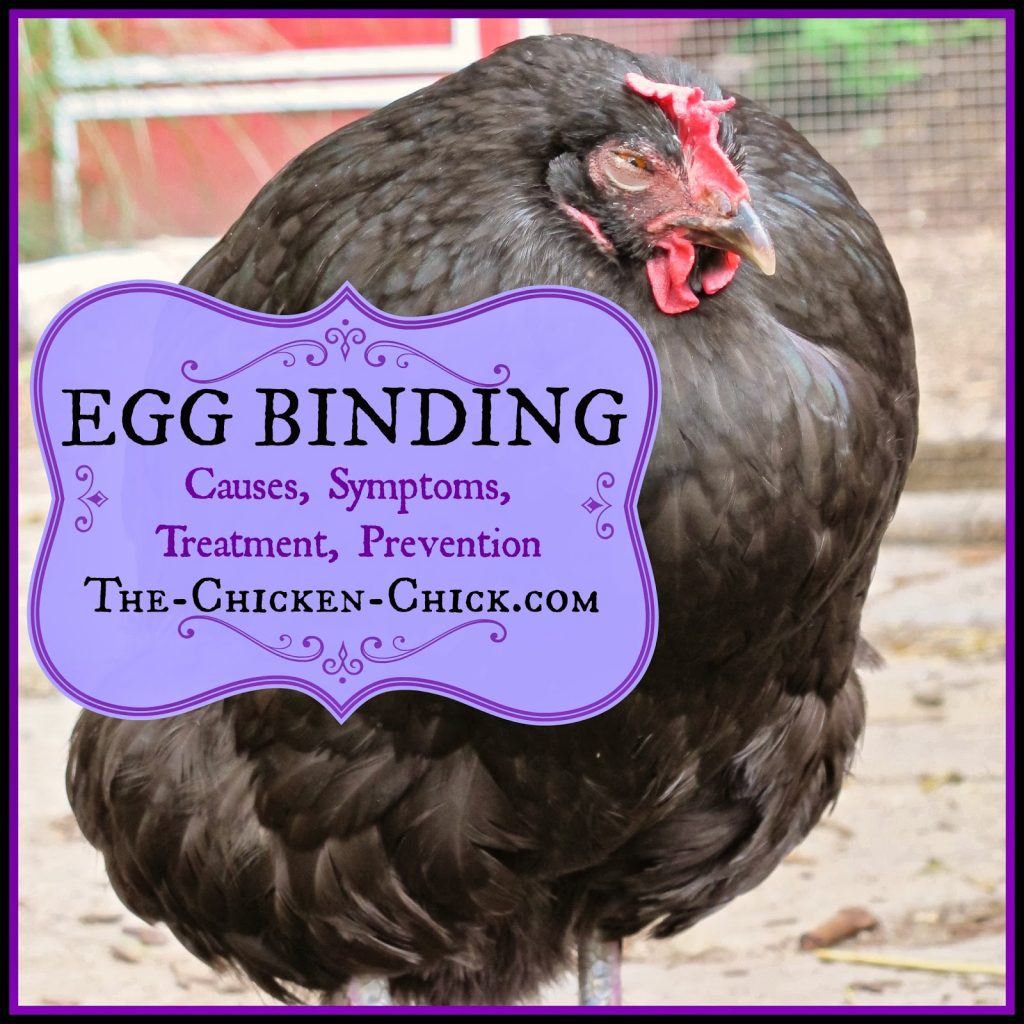
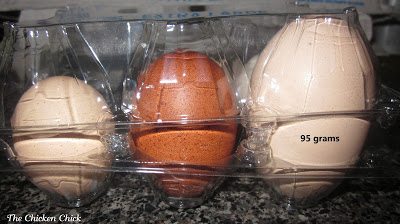
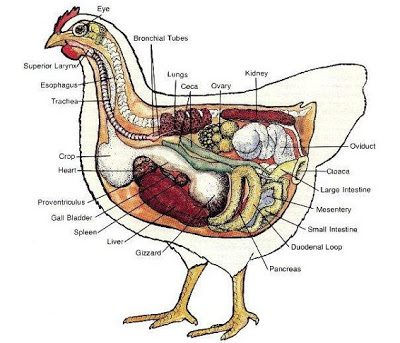
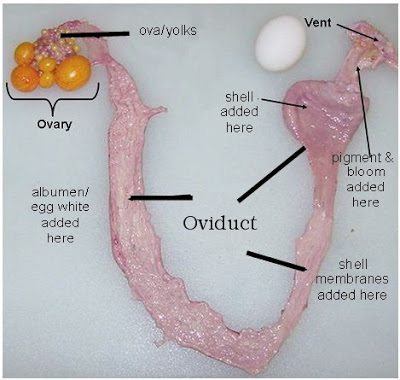
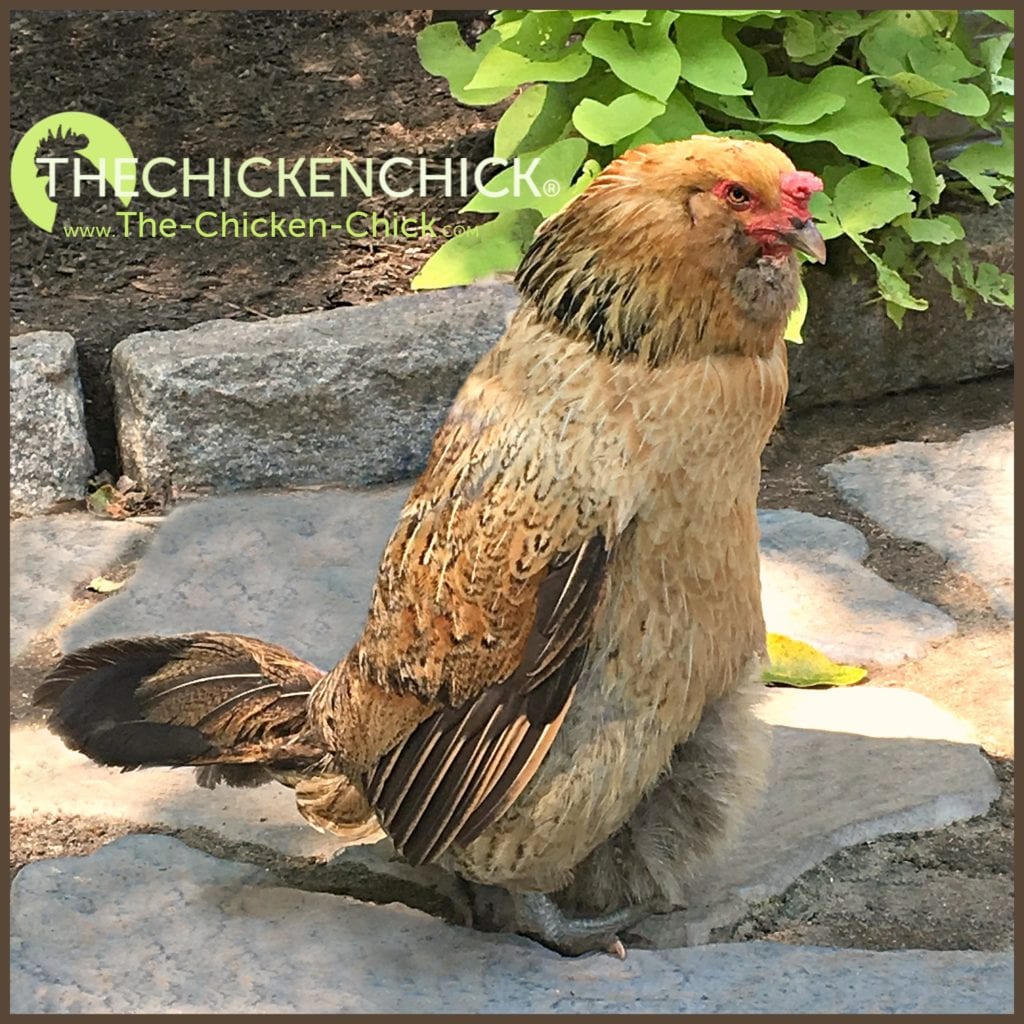
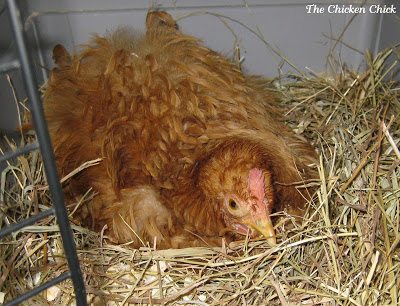
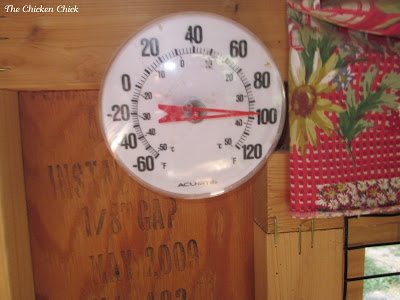
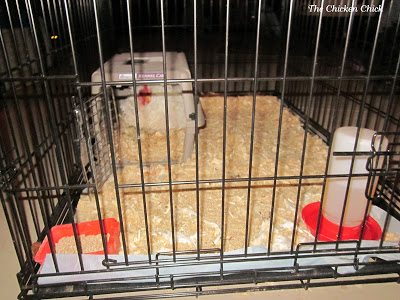
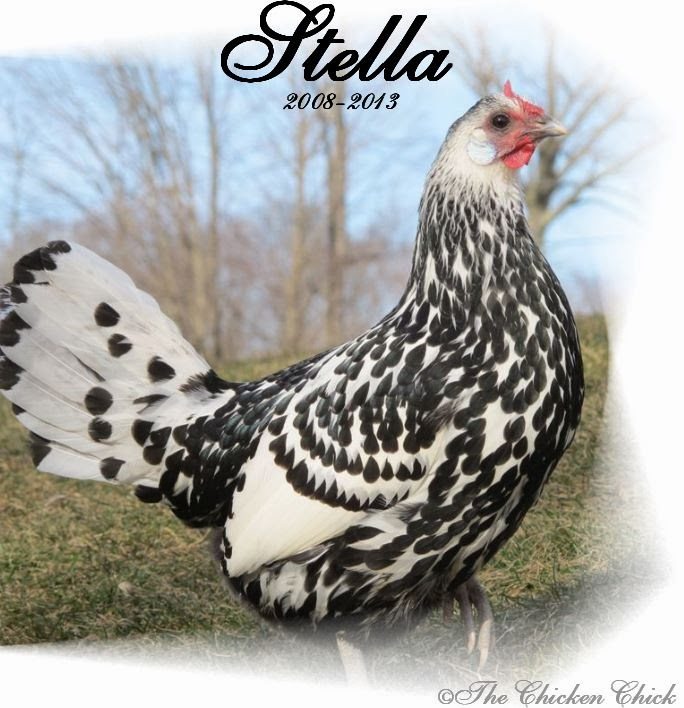













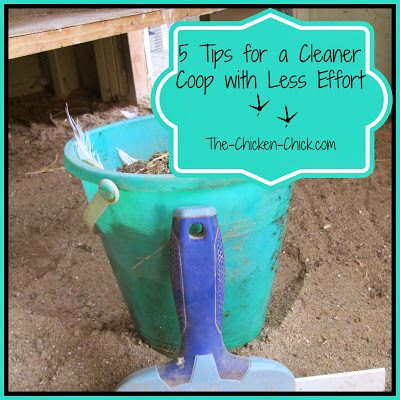
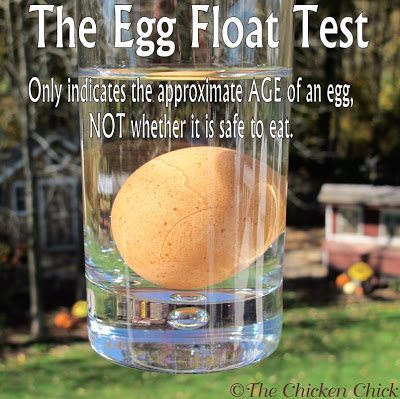










We offer crushed oyster shell in a large terra cotta flower pot. They even dust bathe in it. They're such goofy birds.
I wonder- could you offer milk or yogurt in a calcium emergency? Normally we don't feed dairy but would it be ok?
Thanks for this. You are a wonderful resource and a fun read!
The calcium would not get in their bloodstream quickly enough from yogurt or milk. The other problem is that chickens do not have the enzymes necessary to digest milk sugars, which can cause gastric distress and diahhrea. Best not to add insult to injury during an egg binding crisis.
Great post! Really helpful information!!
Excellent article. I once became worried that a hen had a stuck egg, but she was just broody. Then I would have not known what to do. I feel much better prepared with this information. But I still home I don't have to use it.
Thank you Charlotte. I hope you don't ever need it too!
Very timely repost of this article! My new True Araucana hen has an egg that, for the last 3 days, could be felt in the abdomen through gentle palpation. She is not yet uncomfortable appearing, "walking funny," nor is straining. Defecation is continuing in what appears to be well formed/non-watery movements. (Gastric obstructions often are also dealt with by the body through increasing the liquidity of the stools.) I've been giving her warm water soaks every few hours… then I remembered you posted this the other day, and here I am! Next, I'm going to the store for water based… Read more »
Jen, if she is truly eggbound, she could die by the time the calcium arrives in the mail. I'm astonished that she has had an egg stuck for three days and is still alive and walking. Get some vitamins and electrolytes into her right away- every feed store carries some version, you may even get lucky and find liquid or powdered calcium depending on how big your feed store is. Might even check Petco or PetSmart locally. I'm wondering if what you're feeling might be something else due to the amount of time you describe the lump as being there.… Read more »
Thanks, Kathy. Frankly I was surprised too… it was an assumption I jumped to, since the mass in question is hard and the same shape as an egg… and will move with abdominal massage/manipulation. It is larger than the 2.5 finger distance between pelvic bones… preventing any visualization, were that even possible. I have already administered a nutrient drench, and am heading to PetSmart/Petco first thing in the morning to look for a liquid calcium. I'm not very encouraged by what I'm reading about egg peritonitis either. I wish I could afford a visit to our vet or the Avian… Read more »
Please keep me posted, Jenn. I wish you the best.
Thank you Kathy, Amelia is still doing the same, which is good since there is no obvious discomfort, her posture is normal, and she is still eating/drinking. Right now we have tetracycline in her water, just in case. She is in her own, dimly lit coop, for the moment. The calciBoost got here today, so I'm giving it to her according to recommendations. It couldn't hurt! She still has that egg shaped, hard mass in her abdomen… and hasn't laid an egg for over a week now. Right now we're choosing just to "wait and see." If nothing happens in… Read more »
Can you give us an update? My Turken started acting funny – more sluggish than normal with a messy bum two days ago. I've done the baths and lube and nothing. I'm worried about egg yoke peritonItis too but she has a mass like an egg in her abdomen. It's been a few days now (she just started laying and isn't regular so maybe it's been there longer? I don't know) and I'm not sure what to do. Your story seems most similar to mine so I thought I'd ask how your hen was . Hope she's ok!
very informative article, hope I never have to deal with an egg bound hen tho
I hope that for you too!